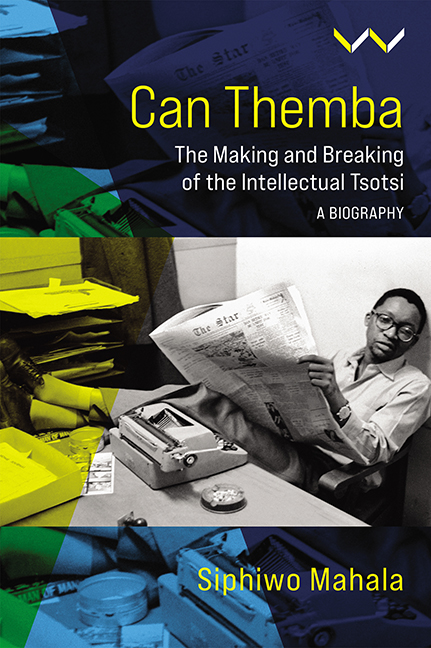Book contents
- Frontmatter
- Dedication
- Epigraph
- Contents
- List of Illustrations
- Acknowledgements
- Introduction
- PART I Death and Birth of a Scribe
- PART II ‘Live Fast and Die Young’
- PART III The ‘Intellectual Tsotsi’
- PART IV Dances with Texts: Writing and Storytelling
- PART V A Writer’s Immortality
- Postscript: The Three Burials of Can Themba
- Notes
- Bibliography
- Index
4 - From Marabastad to Sophiatown and Beyond
Published online by Cambridge University Press: 26 May 2022
- Frontmatter
- Dedication
- Epigraph
- Contents
- List of Illustrations
- Acknowledgements
- Introduction
- PART I Death and Birth of a Scribe
- PART II ‘Live Fast and Die Young’
- PART III The ‘Intellectual Tsotsi’
- PART IV Dances with Texts: Writing and Storytelling
- PART V A Writer’s Immortality
- Postscript: The Three Burials of Can Themba
- Notes
- Bibliography
- Index
Summary
For Can Themba, the African township represented the strength and the will to survive by ordinary masses of the African people. In its own way the township represented a dogged defiance against official persecution, for in the township the moments of splendour were very splendid indeed,surpassing anything white Johannesburg could offer.
Lewis Nkosi — Writing Home (2016), 206–207After completing his studies at Fort Hare, Can Themba moved back to the Transvaal in 1949, where he settled in Sophiatown, a freehold township outside Johannesburg. He was soon to become one of its most iconic figures.
Today he stands out as one of the most prominent chroniclers of Sophiatown of the 1950s. This is evident both in his fiction and in his journalistic pieces, in which Sophiatown is the dominant setting. He writes with great conviction about its personalities, its shebeens, the poetry and politics of the place, some of the key historic moments, and, finally, its destruction. Sophiatown is where he came of age as a writer and journalist, earning himself yet another moniker: the ‘Sage of Sophiatown’.
Themba wrote about the cracks and crannies of Sophiatown with cinematic vividness, great passion and unparalleled erudition, demonstrating intimate connection with the area. In The Beat of the Drum, his reflections of the period, Jim Bailey writes that Themba’s ‘understanding of the black townships of Johannesburg was intuitive, complete and magical’. In his own ‘Requiem for Sophiatown’, Themba describes life in the area as ‘swarming, cacophonous, strutting, brawling, vibrating …’ Stories like his much-celebrated ‘The Suit’, ‘The Will to Die’ and ‘Bottom of the Bottle’ all explore the anxieties and the ecstasies, the crudities and crevices of everyday life in Sophiatown.
The social architecture of Sophiatown went against the newly enacted Group Areas Act, which classified South Africans according to race and dictated where they were permitted to live, thus preventing harmony and equality. One of the many reasons it was targeted by the apartheid government was because of its multiracial character, as it was a freehold township, one of very few areas in South Africa where Africans could and did own stands or property alongside their white counterparts. Its very existence made a mockery of the divisive policies of the apartheid government.
- Type
- Chapter
- Information
- Can ThembaThe Making and Breaking of the Intellectual Tsotsi, a Biography, pp. 42 - 48Publisher: Wits University PressPrint publication year: 2022



